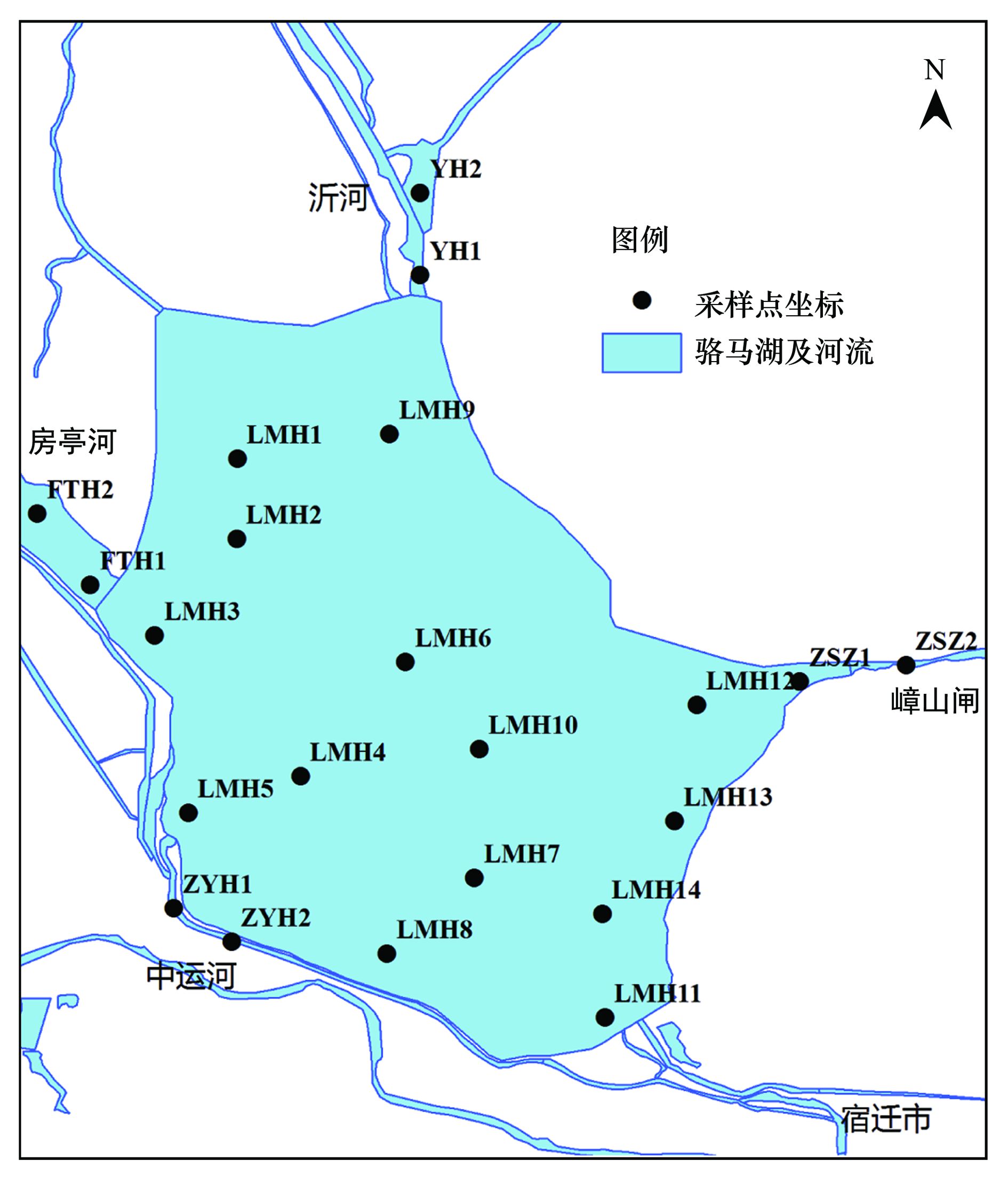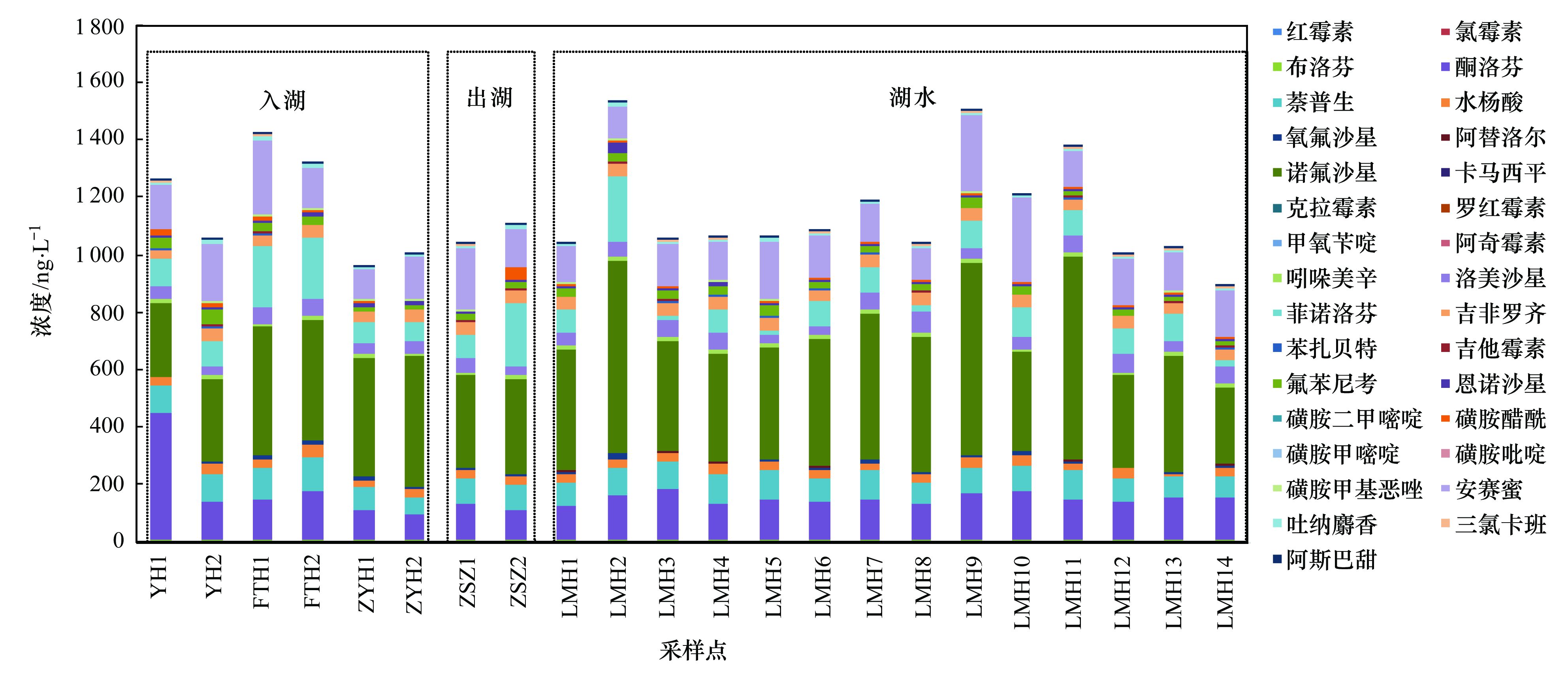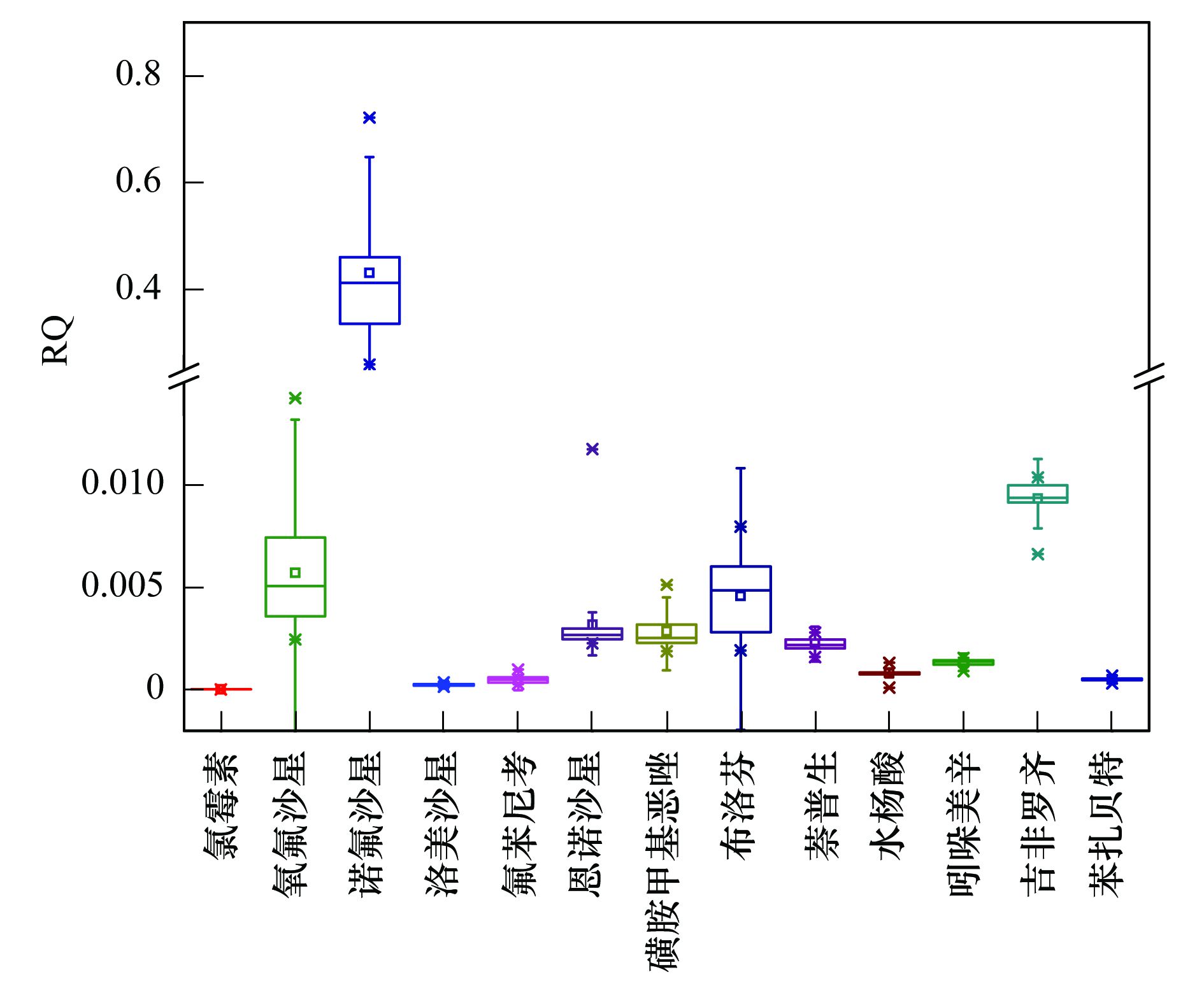药品和个人护理品(pharmaceuticals and personal care products,PPCPs)涵盖所有人用和兽用的医药品、 诊断、 保健品、 麝香、 化妆品、 遮光剂、 消毒剂以及在PPCPs生产制造中添加的组分,如赋形剂、 防腐剂等,包含了很多近年来环境高关注的新型污染物[1]. 大部分PPCPs类物质具有生物活性、 高极性、 光学活性[2]. PPCPs类物质持续进入环境,在地表水、 饮用水、 土壤、 底泥等环境介质中普遍检出,通常在ng·L-1~μg·L-1水平[3~6],影响水生生物等的正常生命活动,并通过食物链最终影响到人类健康[7]. 如长期滥用抗生素类PPCPs会导致动物体内及环境中耐药菌(ARB)大量繁殖,诱导产生抗生素抗性基因(ARGs),一旦传递进入人类致病菌中,将降低感染性疾病治愈的可能,对人类健康产生严重影响[8, 9]. 我国是PPCPs生产与使用大国,对PPCPs物质在环境中的分布及污染开展调查具有十分重要的意义. 目前关于PPCPs污染水平的研究多集中在生活污水处理厂[6, 10, 11],地表水作为污染物的重要的汇,近年来也有相关报道. 徐维海[12]报道了珠江广州河段较为严重的抗生素药物类污染,含量大多在几百μg·L-1. 南方某水库水体中检出了8种抗生素,浓度范围在1.20~130.00 μg·L-1[13]. 同时,北京、 常州和深圳河流中检出了28种PPCPs[14]. 表明抗生素药物在水环境中的普遍存在.
骆马湖位于江苏省北部,是江苏省四大湖泊之一,也是国家南水北调线路水库之一. 本研究使用高效液相色谱-串联三重四级杆质谱(HPLC-MS/MS)对于骆马湖中的32种PPCPs进行了测定,对其分布特征及生态风险进行了分析. 本研究对于了解我国地表水中PPCPs的赋存特征以及生态风险具有重要意义,以期为国家环境部门PPCPs管控提供数据支持.
1 材料与方法 1.1 仪器与试剂HPLC-MS/MS (LC:Agilent Technologies 1290 Infinity; MS/MS:AB SCIEX QTRAP 4500,美国); 色谱柱(Poroshell 120 EC-C18 2.7 μm 2.1×75 mm Column,Agilent Technologies); 旋转蒸发仪(BUCHI,瑞士),电子天平(MS105DU,瑞士); 氮吹仪(ANPEL,安谱); 固相萃取装置(Waters,美国); HLB固相萃取柱(5 mg,6cc,Waters,美国); 甲醇(色谱纯,MERCK,德国). 32种PPCPs标准品均购自百灵威科技,纯度均>99.0%,具体的物质名称见表 1.
|
|
表 1 32种PPCPs的质谱测定条件 Table 1 MS parameters of 32 PPCPs |
1.2 样品采集
骆马湖地处江苏省北部,地跨宿迁、 徐州二市,共辖9个乡镇57个行政村. 湖区北起堰头村(徐州市)圩堤,南至洋河滩闸口(宿迁市),直线长27 km,西连中运河(宿迁段),东临马陵山南麓——嶂山岭(徐州市),平均宽13 km,总面积375 km2. 地理位置在北纬34°00′~34°14′,东经118°06′~118°16′,位于陇海经济带、 沿海经济带、 沿江经济带交叉辐射区. 本研究于2016年4月6~7日对于骆马湖表层水进行了采集,共设置22个采样点(14个湖体样点,6个入湖河流样点、 2个出湖河流样点),采样点的分布如图 1,表层水采样点的采集深度为100~150 cm.

|
图 1 骆马湖采样点分布示意 Fig. 1 Location of sampling sites in Luomahu Lake |
1.3 样品前处理
所采水样预先用盐酸调节pH 2~4左右. 将水样过0.45 μm孔径玻璃纤维膜后,准确量取500 mL抽滤后的水样过预先用甲醇活化的Oasis HLB小柱进行固相萃取,上样速度约为5mL·min-1. 上样后,用10 mL的超纯水淋洗HLB小柱,并在负压条件下抽真空30 min使其干燥,用10.0 mL甲醇洗脱,洗脱液经氮吹至干,然后用甲醇定容到1 mL,涡旋振荡1 min,用HPLC-MS/MS分析.
1.4 样品测定质谱测定条件:采用电喷雾离子源(ESI)、 负离子模式和正离子模式、 多反应离子监测扫描定量分析目标物. HPLC条件:柱温:30℃; 流速0.3mL·min-1; 流动相:正离子模式使用乙腈(A)和0.1% 甲酸/水(体积比)(B),负离子模式使用乙腈和0.2% 氨水/水(体积比),梯度洗脱条件如表 2所示,质谱测定条件如表 1所示.
|
|
表 2 32种PPCPs的正负离子模式下的梯度洗脱条件 Table 2 Gradient elution condition of 32 PPCPs in positive and negative ion modes |
1.5 质量保证和控制(QA/QC)
实验的准确性由回收率实验和空白实验保证. 在不含目标化合物的空白水样中添加PPCPs标样溶液,按照前述方法对样品进行前处理和仪器分析,采用外标法进行定量分析. 水样中PPCPs回收率为85.6%~106%,相对标准偏差为5.9%~9.8%,各目标化合物的检出限为0.5~8.6 ng·L-1.
空白实验的目的是识别并定量采样、 前处理及仪器分析等阶段目标化合物的污染,包括现场空白和程序空白. 采样时,将500 mL高纯水置于棕色玻璃采样瓶中,携带至取样现场,采样时暴露于周围环境,采样结束后,与实际水样一同运送至实验室,测定其中目标PPCPs的浓度,该样品为现场空白. 实验室分析前,再准备一定量的高纯水,测定其中目标PPCPs的浓度,作为程序空白. 实际样品测试时,每批除实际水样和1 个程序空白外,还包括1 个以高纯水为介质的加标样品,以监测该批样品各PPCPs 在前处理过程中的回收率情况. 此外,每点水样采集两份,进行平行双样测定,以保证实验测定的精密性.
1.6 风险评价方法 1.6.1 生态风险评价根据欧盟关于环境风险评价的技术指导,采用风险商值法(risk quotient,RQ)评估骆马湖水环境中的环境风险等级. 风险商值RQ的计算公式如下,即实际测定浓度(measured environmental concentration,MEC)和无效应浓度(predicted no effect concentration,PNEC)之间的比值,见式(1).

|
(1) |
PNEC值通常由实验所得的急性和慢性毒性数据(LC50、 EC50、 NOEC等)除以评估因子(assessment factors,AF)得到,毒性数据可通过ECTOX查询获得,AF的取值范围在10~1 000. 根据RQ 值的大小,分为3个环境风险等级,即RQ值在0.01~0.1间为低环境风险,在0.1~1.0 间为中等环境风险,大于1为高环境风险[15]. 水环境中的PPCPs不是单一存在的,少量研究表明,水环境中多种PPCPs共存时,环境危害作用会因共存而加强[16, 17]. 因此本文采用Quinn等[18]报道的简单叠加模型[式(2)]计算PPCPs的联合毒性风险熵(RQsum),其中RQi为第i个PPCP的RQ.

|
(2) |
水源水中的抗生素对人体健康风险评价是基于风险熵的方法,并同时考虑对不同年龄段人群的风险,若风险熵大于1,则认为是有风险[19],具体的计算方法见公式(3)及(4).

|
(3) |

|
(4) |
式中,cs是PPCPs的检出浓度(μg·L-1); DWEL是饮用水当量值(μg·L-1); ADI是日均可接受摄入量[μg·(kg·d)-1]; BW是人均体重(kg); HQ是最高风险,按1计算; DWI是每日饮水量(L·d-1); AB 是胃肠吸收率,按1计算,FOE是暴露频率(350 d·a-1),按0.96 计算. BW和DWI 的相关数据采用美国环保署(EPA)推荐值[20].
2 结果与讨论 2.1 水体中32种PPCPs的污染水平骆马湖水体中32种PPCPs共检出23种,包括10种抗生素类、 5种消炎止痛药类,以及其他类药物4种; 2种食品添加剂在所有样品中均有检出,三氯卡班及吐纳麝香在所有样品中均有检出. 各采样点总PPCPs浓度范围为892~1 536 ng·L-1,平均值为1 148 ng·L-1(见图 2).

|
图 2 骆马湖32种PPCPs的浓度水平和分布特征 Fig. 2 Concentration and distribution of 32 PPCPs in Luomahu Lake |
32种化合物浓度最高的为诺氟沙星,占总PPCPs浓度的20.3%~51.4%,其次是酮洛芬(8.43%~34.8%)、 安赛蜜(7.29%~23.9%)、 萘普生(6.07%~10.1%). 4种化合物合计共占总PPCPs的59.1%~79.1%. 各采样点呈现较为相似的分布特征.
17种抗生素类药物的总浓度范围为378~831 ng·L-1,其中红霉素、 克拉霉素、 罗红霉素、 甲氧苄啶、 阿奇霉素、 磺胺二甲嘧啶、 磺胺甲嘧啶及磺胺吡啶在所有采样点均低于定量限. 诺氟沙星的浓度范围为256~707 ng·L-1. 徐维海等[12]报道了珠江广州河段洪季和枯季的诺氟沙星分别为nd~13 ng·L-1和117~251 ng·L-1,低于本研究. 氯霉素在所有点的平均浓度为2.95 ng·L-1,远低于徐维海等[21]报道的11~266 ng·L-1. 洛美沙星在所有采样点均有检出,浓度范围为28.4~2.5 ng·L-1.
6种消炎止痛类药物的总浓度范围为264~676 ng·L-1,平均值为387 ng·L-1. 6种药物在所有采样点均有检出,浓度最高的为酮洛芬,浓度范围为85~438 ng·L-1. 其次为菲诺洛芬及萘普生,平均浓度分别为98 ng·L-1及90 ng·L-1.
4种其他类药物浓度较低,其中吉非罗齐浓度范围为29~45 ng·L-1,卡马西平在所有采样点均未检出,阿替洛尔和苯扎贝特浓度较低,处在几ng·L-1的水平. 王丹等[22]报道了黄浦江水域的抗生素的含量,其中苯扎贝特浓度水平为nd~6 ng·L-1,与本研究处于相似的水平,卡马西平浓度为9~190 ng·L-1,高于本研究. 西班牙Madrid河被报道有较高的苯扎贝特浓度[23],为234~2 315 ng·L-1,远高于本研究,这主要与不同的药物使用习惯有关.
两种食品添加剂中安赛蜜的浓度较高,为101~290 ng·L-1. 安赛蜜是一种人工合成甜味剂,人工甜味剂在污水处理设施中不能被完全去除,因而随着污水处理厂的出水进入收纳水体[24]. 国内外很多研究结果表明,安赛蜜是环境介质中主要检出的人工甜味剂,比如Scheurer等[25]对德国河流调查发现安赛蜜的浓度高达2 μg·L-1,是其他甜味剂的10倍. 瑞士格里芬湖检出了安赛蜜,浓度为2.8 μg·L-1 [26]. 干志伟[27]报道了海河中安赛蜜的浓度为1.6~7.6 μg·L-1,均远高于本研究的水平.
三氯卡班是一种高效广谱的抗菌剂,广泛应用于洗涤用品、 化妆品、 消毒剂等. 因而随生活污水的排放而进入环境. 骆马湖检测到的三氯卡班浓度为2.56~4.26 ng·L-1,略高于王明泉等[28]报道的南水北调山东受水区水源水(0.6~1.7 ng·L-1). 合成麝香是一类广泛添加于各种个人护理用品的香味合成有机物,是一种新型的环境污染物,代表性的为吐纳麝香. 马莉等[29]报道了太湖梅梁湾水体中吐纳麝香浓度为0.04~0.23 ng·L-1. 本研究中吐纳麝香浓度为10.4~19.6 ng·L-1,与太湖相比处于较高的水平,但远低于国外报道的合成麝香的浓度(德国Hessen地区河流3~299 ng·L-1,意大利Molgora河97 ng·L-1)[30, 31],这主要与合成麝香在中国的使用量较少有关.
2.2 水体中32种PPCPs的空间分布特征骆马湖周围主要入湖河道包括:沂河、 中运河、 房亭河和韩庄运河,骆马湖洪水主要出路是自嶂山闸. 本研究分别在沂河、 中运河、 房亭河及嶂山闸以及湖体分别进行了样品的采集. 图 1为骆马湖进湖、 出湖及湖体各采样点PPCPs的含量分布. 总体上看,不同采样位点的PPCPs浓度存在一定的空间差异,呈现湖东北部地区较高,南部地区较低的趋势. 房亭河入口处PPCPs浓度较高(总浓度1 370 ng·L-1),这可能是由于房亭河流经地区人口较为密集,药物使用较多、 而房亭河主要流经的土山、 议堂、 碾庄镇等7个乡镇都没有集中污水处理厂,镇内的所有生活污水未经处理直接排入房亭河及其支流[32],同时,房亭河区有各类排污口包括生活污水排放口、 工业和生活废水口等,排入房亭河的生活污水为PPCPs的重要来源. 在房亭河入湖口附近的LMH2检测到较高水平的PPCPs(1 536 ng·L-1). 沂河入湖口两采样点PPCPs与整体相比略高(1 159 ng·L-1),该入湖口附近的LMH9也检测到了较高的PPCPs(1 503 ng·L-1). 中运河入湖口PPCPs较低,其附近的LMH4、 LMH5、 LMH8浓度也较低. 另外,出湖口嶂山闸检测到的PPCPs处于较低的水平,这可能是由于进入湖体的PPCPs经过湖水的稀释作用,同时,据报道,一些PPCPs容易吸附在有机质含量较高的悬浮颗粒物以及沉积物中[33],骆马湖中存在的悬浮颗粒物对于一些物质的吸附以及蓄积作用可能也是出湖PPCPs浓度较低的原因. 整体上看,湖体中的PPCPs分布与其附近的入湖口与出湖口保持较好的一致性,这表明入湖河流中PPCPs是湖体中PPCPs污染的主要来源.
2.3 生态风险评估基于最坏情况考虑,RQs的计算采用筛选出的最敏感物种的PNEC. 本文对于检出的药物类PPCPs进行了风险评估,其中吉他霉素、 磺胺醋酰、 酮洛芬、 非诺洛芬及阿替洛尔未查到其毒性数据,因此对于其他13种药物类PPCPs进行了生态风险评估,其对应对敏感物种的毒理数据见表 3.
|
|
表 3 13种药物类PPCPs最敏感物种毒理数据 Table 3 Most sensitive species toxicity data of 13 pharmaceutical PPCPs |
骆马湖的生态风险评估结果见图 3. 所有的13种药物类RQs均小于1,不具有高风险. 诺氟沙星RQ为0.26~0.72,均大于0.1,表现为中风险,说明其对于骆马湖水体中的相应的水生生物表现出中等的急性或慢性毒性风险. 吉非罗齐在大部分采样点RQ>0.01,表现为低风险,表明了其对于水生生物较低的急性或慢性毒性风险. 对于其他11种PPCPs,RQs≤0.01,说明其对于骆马湖的生态风险不显著. PPCPs的联合毒性风险熵范围为0.29~0.75,主要是由于诺氟沙星的贡献,整体上看,骆马湖PPCPs对于水生生物表现出中风险.

|
图 3 13种药物类PPCPs的生态风险RQs Fig. 3 Ecological risk RQs of 13 pharmaceutical PPCPs |
2.4 人体健康风险评估
由于有些PPCPs的ADI不易获得,因此本研究选取代表性的6种PPCPs,对其进行了不同年龄段的人体健康风险评价,从婴幼儿到成人不同年龄段人群的健康风险如表 4所示. 6种典型的PPCPs的RQs均小于1,整体上呈现随年龄增长RQs降低的趋势,对于0~3个月婴儿表现出最高的风险,16~18岁青少年表现出最低的健康风险. 6种化合物中诺氟沙星对人体的健康风险最高,这与水体中诺氟沙星的浓度较高有关,阿替洛尔风险较低,RQs范围为0.000 2~0.001 1. 结果表明骆马湖水体中的PPCPs对人体健康无直接风险.
|
|
表 4 6种典型PPCPs的人体健康风险RQs Table 4 Human health risk RQs of 6 typical PPCPs |
3 结论
(1) 骆马湖水体中共检出了23种PPCPs,包括10种抗生素类、 5种消炎止痛药类、 4种其他类药物、 2种食品添加剂、 杀菌剂三氯卡班及吐纳麝香. 整体上,除诺氟沙星浓度较高外,其余的PPCPs处于较低的水平.
(2) 骆马湖水体中PPCPs呈现东北部高于西南部的空间分布特征,湖体中的PPCPs分布与其附近的入湖口与出湖口保持较好的一致性,这表明入湖河流中PPCPs是湖体中PPCPs污染的主要来源.
(3) 对于13种药物类PPCPs生态风险评估结果表明,12种PPCPs 生态风险RQs≤0.01,说明其对于骆马湖的生态风险不显著,诺氟沙星表现出中风险,对于骆马湖水生系统的影响不容忽视,同时12种PPCPs的联合毒性风险熵表明整体上PPCPs对于骆马湖水生生物表现出中风险.
(4) 6种PPCPs对于10个不同年龄段的人体健康风险评估表明,健康风险RQs<0.1,骆马湖水体中的PPCPs,对于人体健康尚不具有明显的风险.
| [1] | Buchberger W W. Current approaches to trace analysis of pharmaceuticals and personal care products in the environment[J]. Journal of Chromatography A, 2011, 1218(4) : 603–618. DOI: 10.1016/j.chroma.2010.10.040 |
| [2] | Daughton C G. Pharmaceuticals and personal care products in the environment:overarching issues and overview[A]. In:Daughton C G, Jones-Lepp T L, (Eds.). Pharmaceuticals and Care Products in the Environment[M]. Washington, DC, USA:American Chemical Society, 2001, 791:2-38. |
| [3] | Boyd G R, Reemtsma H, Grimm D A, et al. Pharmaceuticals and personal care products (PPCPs) in surface and treated waters of Louisiana, USA and Ontario, Canada[J]. Science of the Total Environment, 2003, 311(1-3) : 135–149. DOI: 10.1016/S0048-9697(03)00138-4 |
| [4] | Zhang T, Wu B, Sun N, et al. Sorption and degradation of wastewater-associated pharmaceuticals and personal care products in agricultural soils and sediment[J]. Water Science & Technology, 2013, 68(5) : 991–998. |
| [5] | Barceló D, Petrovic M. Pharmaceuticals and personal care products (PPCPs) in the environment[J]. Analytical and Bioanalytical Chemistry, 2007, 387(4) : 1141–1142. DOI: 10.1007/s00216-006-1012-2 |
| [6] | 温智皓, 段艳平, 孟祥周, 等. 城市污水处理厂及其受纳水体中5种典型PPCPs的赋存特征和生态风险[J]. 环境科学, 2013, 34(3) : 927–932. Wen Z H, Duan Y P, Meng X Z, et al. Occurrence and risk assessment of five selected PPCPs in municipal wastewater treatment plant and the receiving water[J]. Environmental Science, 2013, 34(3) : 927–932. |
| [7] | Bu Q W, Wang B, Huang J, et al. Pharmaceuticals and personal care products in the aquatic environment in China:a review[J]. Journal of Hazardous Materials, 2013, 262 : 189–211. DOI: 10.1016/j.jhazmat.2013.08.040 |
| [8] | Zhang X X, Zhang T, Fang H H P. Antibiotic resistance genes in water environment[J]. Applied Microbiology and Biotechnology, 2009, 82(3) : 397–414. DOI: 10.1007/s00253-008-1829-z |
| [9] | 罗义, 周启星. 抗生素抗性基因(ARGs)——一种新型环境污染物[J]. 环境科学学报, 2008, 28(8) : 1499–1505. Luo Y, Zhou Q X. Antibiotic resistance genes (ARGs) as an emerging pollutants[J]. Acta Scientiae Circumstantiae, 2008, 28(8) : 1499–1505. |
| [10] | Ort C, Lawrence M G, Reungoat J, et al. Sampling for PPCPs in wastewater systems:comparison of different sampling modes and optimization strategies[J]. Environmental Science & Technology, 2010, 44(16) : 6289–6296. |
| [11] | Kosma C I, Lambropoulou D A, Albanis T A. Occurrence and removal of PPCPs in municipal and hospital wastewaters in Greece[J]. Journal of Hazardous Materials, 2010, 179(1-3) : 804–817. DOI: 10.1016/j.jhazmat.2010.03.075 |
| [12] | 徐维海. 典型抗生素类药物在珠江三角洲水环境中的分布、行为与归宿[D]. 广州:中国科学院广州地球化学研究所, 2007. Xu W H. Occurrence and environmental fate of selected antibiotics in the aquatic environment of the Pearl river delta[D]. Guangzhou:Guangzhou Institute of Geochemistry, Chinese academy of Sciences, 2007. |
| [13] | 朱婷婷, 宋战锋, 尹魁浩, 等. 南方某水库水体中抗生素生态与健康风险研究[J]. 生态毒理学报, 2015, 10(5) : 124–131. Zhu T T, Song Z F, Yin K H, et al. Assessments of ecological and health risk induced by antibiotics in source water of a reservoir in a southern city[J]. Asian Journal of Ecotoxicology, 2015, 10(5) : 124–131. |
| [14] | Wang Z, Zhang X H, Huang Y, et al. Comprehensive evaluation of pharmaceuticals and personal care products (PPCPs) in typical highly urbanized regions across China[J]. Environmental Pollution, 2015, 204 : 223–232. DOI: 10.1016/j.envpol.2015.04.021 |
| [15] | Taneda S, Mori Y, Kamata K, et al. Estrogenic and anti-androgenic activity of nitrophenols in diesel exhaust particles (DEP)[J]. Biological and Pharmaceutical Bulletin, 2004, 27(6) : 835–837. DOI: 10.1248/bpb.27.835 |
| [16] | Cleuvers M. Mixture toxicity of the anti-inflammatory drugs diclofenac, ibuprofen, naproxen, and acetylsalicylic acid[J]. Ecotoxicology and Environmental Safety, 2004, 59(3) : 309–315. DOI: 10.1016/S0147-6513(03)00141-6 |
| [17] | Cleuvers M. Aquatic ecotoxicity of pharmaceuticals including the assessment of combination effects[J]. Toxicology Letters, 2003, 142(3) : 185–194. DOI: 10.1016/S0378-4274(03)00068-7 |
| [18] | Quinn B, Gagné F, Blaise C. An investigation into the acute and chronic toxicity of eleven pharmaceuticals (and their solvents) found in wastewater effluent on the cnidarian, Hydra attenuata[J]. Science of the Total Environment, 2008, 389(2-3) : 306–314. DOI: 10.1016/j.scitotenv.2007.08.038 |
| [19] | Cunningham V L, Binks S P, Olson M J. Human health risk assessment from the presence of human pharmaceuticals in the aquatic environment[J]. Regulatory Toxicology & Pharmacology, 2009, 53(1) : 39–45. |
| [20] | US EPA (U.S. Environmental Protection Agency). Guidance on selecting age groups for monitoring and assessing childhood exposures to environmental contaminants[EB/OL]. https://www.epa.gov/risk/guidance-selecting-age-groups-monitoring-and-assessing-childhood-exposures-environmental,2016-08. |
| [21] | 徐维海, 张干, 邹世春, 等. 香港维多利亚港和珠江广州河段水体中抗生素的含量特征及其季节变化[J]. 环境科学, 2006, 27(12) : 2458–2462. Xu W H, Zhang G, Zou S C, et al. Occurrence and seasonal changes of antibiotics in the victoria harbour and the Pearl River, South China[J]. Environmental Science, 2006, 27(12) : 2458–2462. |
| [22] | 王丹, 隋倩, 吕树光, 等. 黄浦江流域典型药物和个人护理品的含量及分布特征[J]. 中国环境科学, 2014, 34(7) : 1897–1904. Wang D, Sui Q, Lv S G, et al. Concentrations and distribution of selected pharmaceuticals and personal care products in Huangpu River[J]. China Environmental Science, 2014, 34(7) : 1897–1904. |
| [23] | Valcárcel Y, Alonso S G, Rodríguez-Gil J L, et al. Analysis of the presence of cardiovascular and analgesic/anti-inflammatory/antipyretic pharmaceuticals in river-and drinking-water of the Madrid Region in Spain[J]. Chemosphere, 2011, 82(7) : 1062–1071. DOI: 10.1016/j.chemosphere.2010.10.041 |
| [24] | Scheurer M, Storck F R, Brauch H J, et al. Performance of conventional multi-barrier drinking water treatment plants for the removal of four artificial sweeteners[J]. Water Research, 2010, 44(12) : 3573–3584. DOI: 10.1016/j.watres.2010.04.005 |
| [25] | Scheurer M, Brauch H J, Lange F T. Analysis and occurrence of seven artificial sweeteners in German waste water and surface water and in soil aquifer treatment (SAT)[J]. Analytical and Bioanalytical Chemistry, 2009, 394(6) : 1585–1594. DOI: 10.1007/s00216-009-2881-y |
| [26] | Buerge I J, Buser H R, Kahle M, et al. Ubiquitous occurrence of the artificial sweetener acesulfame in the aquatic environment:an ideal chemical marker of domestic wastewater in groundwater[J]. Environmental Science & Technology, 2009, 43(12) : 4381–4385. |
| [27] | 干志伟. 人工甜味剂在环境中的分布、迁移转化及光降解机理研究[D]. 天津:南开大学, 2014. Gan Z W. Distribution, fate, and photolysis mechanism of artificial sweeteners in environment[D]. Tianjin:Nankai University, 2014. |
| [28] | 王明泉, 李圭白, 贾瑞宝, 等. 南水北调山东受水区水源水环境激素污染特性[J]. 中国给水排水, 2015, 31(23) : 69–71. Wang M Q, Li G B, Jia R B, et al. Environmental hormone pollution characteristics of source water in Shandong province of south-to-north water transfer project[J]. China Water & Wastewater, 2015, 31(23) : 69–71. |
| [29] | 马莉, 敬烨, 周静, 等. 太湖梅梁湾水体合成麝香的分布特征[J]. 环境化学, 2014, 33(4) : 630–635. Ma L, Jing Y, Zhou J, et al. Distribution of synthetic musk in surface water and sediments from Meiliang Bay, Taihu Lake[J]. Environmental Chemistry, 2014, 33(4) : 630–635. |
| [30] | Quednow K, Püttmann W. Organophosphates and synthetic musk fragrances in freshwater streams in Hessen/Germany[J]. Clean-Soil Air Water, 2008, 36(1) : 70–77. DOI: 10.1002/(ISSN)1863-0650 |
| [31] | Villa S, Assi L, Ippolito A, et al. First evidences of the occurrence of polycyclic synthetic musk fragrances in surface water systems in Italy:spatial and temporal trends in the Molgora River (Lombardia Region, Northern Italy)[J]. Science of the Total Environment, 2012, 416 : 137–141. DOI: 10.1016/j.scitotenv.2011.11.027 |
| [32] | 范瑜, 吴涛, 贺晓蕾. 房亭河水质稳定达标存在的问题及其主要对策措施[J]. 环境科技, 2013, 26(6) : 51–54. Fan Y, Wu T, He X L. Problems that prevent Fangting river water from steadily meeting the standards and main countermeasures[J]. Environmental Science and Technology, 2013, 26(6) : 51–54. |
| [33] | Caliman F A, Gavrilescu M. Pharmaceuticals, personal care products and endocrine disrupting agents in the environment-a review[J]. Clean-Soil Air Water, 2009, 37(4-5) : 277–303. DOI: 10.1002/clen.v37:4/5 |
| [34] | Ando T, Nagase H, Eguchi K, et al. A novel method using cyanobacteria for ecotoxicity test of veterinary antimicrobial agents[J]. Environmental Toxicology and Chemistry, 2007, 26(4) : 601–606. DOI: 10.1897/06-195R.1 |
| [35] | Saejung C, Hatai K, Sanoamuang L O. Bath efficacy of sodium hypochlorite, oxytetracycline dihydrate and chloramphenicol against bacterial black disease in fairy shrimp Branchinella thailandensis[J]. Aquaculture Research, 2014, 45(10) : 1697–1705. DOI: 10.1111/are.12115 |
| [36] | Isidori M, Lavorgna M, Nardelli A, et al. Toxic and genotoxic evaluation of six antibiotics on non-target organisms[J]. Science of the Total Environment, 2005, 346(1-3) : 87–98. DOI: 10.1016/j.scitotenv.2004.11.017 |
| [37] | Robinson A A, Belden J B, Lydy M J. Toxicity of fluoroquinolone antibiotics to aquatic organisms[J]. Environmental Toxicology and Chemistry, 2005, 24(2) : 423–430. DOI: 10.1897/04-210R.1 |
| [38] | Seoane M, Rioboo C, Herrero C, et al. Toxicity induced by three antibiotics commonly used in aquaculture on the marine microalga Tetraselmis suecica (Kylin) Butch[J]. Marine Environmental Research, 2014, 101 : 1–7. DOI: 10.1016/j.marenvres.2014.07.011 |
| [39] | Eguchi K, Nagase H, Ozawa M, et al. Evaluation of antimicrobial agents for veterinary use in the ecotoxicity test using microalgae[J]. Chemosphere, 2004, 57(11) : 1733–1738. DOI: 10.1016/j.chemosphere.2004.07.017 |
| [40] | Brun G L, Bernier M, Losier R, et al. Pharmaceutically active compounds in Atlantic Canadian sewage treatment plant effluents and receiving waters, and potential for environmental effects as measured by acute and chronic Aquatic Toxicity[J]. Environmental Toxicology and Chemistry, 2006, 25(8) : 2163–2176. DOI: 10.1897/05-426R.1 |
| [41] | El-Bassat R A, Touliabah H E, Harisa G I, et al. Aquatic toxicity of various pharmaceuticals on some isolated plankton species[J]. International Journal of Medicine & Medical Sciences, 2011, 3(6) : 170–180. |
| [42] | Marques C R, Abrantes N, Gonçalves F. Life-history traits of standard and autochthonous cladocerans:Ⅱ. Acute and chronic effects of acetylsalicylic acid metabolites[J]. Environmental Toxicology, 2004, 19(5) : 527–540. DOI: 10.1002/tox.20060 |
| [43] | Lister A L, Van Der Kraak G. An investigation into the role of prostaglandins in zebrafish oocyte maturation and ovulation[J]. General and Comparative Endocrinology, 2008, 159(1) : 46–57. DOI: 10.1016/j.ygcen.2008.07.017 |
| [44] | Bulloch D N, Lavado R, Forsgren K L, et al. Analytical and biological characterization of halogenated gemfibrozil produced through chlorination of wastewater[J]. Environmental Science & Technology, 2012, 46(10) : 5583–5589. |
| [45] | Rosal R, Rodea-Palomares I, Boltes K, et al. Ecotoxicity assessment of lipid regulators in water and biologically treated wastewater using three aquatic organisms[J]. Environmental Science & Pollution Research, 2010, 17(1) : 135–144. |
| [46] | Schwab B W, Hayes E P, Fiori J M, et al. Human pharmaceuticals in US surface waters:a human health risk assessment[J]. Regulatory Toxicology and Pharmacology, 2005, 42(3) : 296–312. DOI: 10.1016/j.yrtph.2005.05.005 |
| [47] | Snyder S A. Occurrence, treatment, and toxicological relevance of EDCs and pharmaceuticals in water[J]. Ozone:Science & Engineering, 2008, 30(1) : 65–69. |
| [48] | De Jesus Gaffney V, Almeida C M M, Rodrigues A, et al. Occurrence of pharmaceuticals in a water supply system and related human health risk assessment[J]. Water Research, 2015, 72 : 199–208. DOI: 10.1016/j.watres.2014.10.027 |
 2017, Vol. 38
2017, Vol. 38



